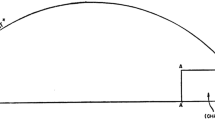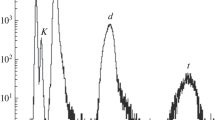Summary
The results of a systematic investigation into the production of heavy unstable particles in energetic nuclear disintegrations is reported. Mass measurements by the grain density-range method have been made in order to detect K-mesons independently of any secondary effects. Measurements were made on tracks which satisfied certain geometrical criteria and which originated in disintegrations of energy greater than ∼2 GeV. The velocity range studied for K-mesons was from 0.25c to 0.56c. Ten K-mesons and two hyperons were found. The two hyperons and one of the K-mesons decayed in flight. All the particles decayed into single charged secondaries. Both hyperons were emitted from disintegrations which also produced K-mesons. These associated pairs have been reported previously (1). The results are consistent with the view that hyperons and heavy mesons are mainly produced in association, and that, in the energy range considered, K-mesons show a large charge disparity. Two additional hyperons were found one of which appears to be an example of the decay scheme Y± → Λ0 + π± + ∼60 MeV. A value for the lifetime of the hyperons is estimated from six suitable examples found in this laboratory. Mass measurements have been made on the tracks of 17 K-mesons. The mean value obtained is 985 ± 16 me.
Riassunto
Si riferisce il risultato di un esame sistematico della produzione di particelle pesanti instabili nelle disintegrazioni nucleari di alta energia. Sono state eseguite misure di massa col metodo densità di grani-range onde rilevare i mesoni K indipendentemente dai loro effetti secondari. Si sono eseguite misure su tracce soddisfacenti determinati criteri geometrici e che traevano origine da disintegrazioni di energia superiore a ∼ 2 GeV. L’intervallo di velocità studiato pei mesoni K è stato da 0,25c a 0,56c. Sono stati trovati 10 mesoni K e 2 iperoni. I due iperoni e uno dei K decadono in volo. Tutte le particelle decadono in secondari a carica semplice. I due iperoni sono emessi in disintegrazioni che producono anche mesoni K. Su queste coppie associate fu già riferito in precedenza (1). I risultati sono compatibili con l’ipotesi che iperoni e mesoni pesanti siano prodotti prevalentemente in associazione, e che, nell’intervallo di energie considerato, i mesoni K mostrino una grande disparità di carica. Si trovarono due ulteriori iperoni, uno dei quali appare essere un esempio dello schema di decadimento Y± → Λ0 + π± + ∼60 MeV. Il tempo di vita degli iperoni è stato stimato in base a sei esempi adatti trovati in questo laboratorio. Misure di massa sono state eseguite sulle tracce di 17 mesoni K. Il valore medio ottenuto è 985 ± 16 me.
Similar content being viewed by others
References
C. Dahanayake, P. E. Francois, Y. Fujimoto, P. Iredale, C. J. Waddington andM. Yasin:Phil. Mag. 7, 45, 855 (1954).
M. W. Friedlander, G. G. Harris andM. G. K. Menon:Proc. Roy. Soc.,221, 394 (1954).
U. Camerini, J. H. Davies, P. H. Fowler, C. Franzinetti, H. Muirhead, W. O. Lock, D. H. Perkins andG. Yekutieli:Phil. Mag.,7, 42, 1241 (1951).
Throughout this paper we have adopted the nomenclature used in theReport of the Committee on K-Particles, Padova Conference Report, inSuppl. Nuovo Cimento,12, 433 (1954).
R. R. Daniel andD. Lal:Proc. Ind. Acad. Sci.,41, 1, 15 (1955).
W. B. Fowler, R. P. Shutt, A. M. Thorndike andW. L. Whittemore:Phys. Rev.,93, 861 (1954).
J. Crussard, M. F. Kaplon, J. Klarmann andJ. H. Noon:Phys. Rev.,93, 253 (1954).
C. Dahanayake, P. E. Francois, Y. Fujimoto, P. Iredale, C. J. Waddington andM. Yasin:Phil. Mag.,7, 45, 1219 (1954).
P. H. Fowler andD. H. Perkins:Report of Padova Conference, inSuppl. Nuovo Cimento,12, 236 (1954).
P. H. Fowler andD. H. Perkins: in press (1955).
R. Armenteros, K. H. Barker, C. C. Butler, A. Cachon andC. M. York:Phil. Mag.,43, 597 (1952). See also,R. B. Leighton:Bagnères Report, p. 97 (1593).
E. W. Cowan:Phys. Rev.,94, 161 (1954).
E. Amaldi, C. Castagnoli, G. Cortini andC. Franzinetti:Nuovo Cimento,12, 5, 668 (1954).
M. W. Friedlander, T. D. Keefe andM. G. K. Menon:Nuovo Cimento,1, 3, 482 (1955).
M. S. Bratlett:Phil. Mag.,7, 44, 249 (1953).
Author information
Authors and Affiliations
Rights and permissions
About this article
Cite this article
Dahanayake, C., Francois, P.E., Fujimoto, Y. et al. On heavy unstable particles produced in high energy nuclear disintegrations. Nuovo Cim 1, 888–903 (1955). https://doi.org/10.1007/BF02731335
Received:
Published:
Issue Date:
DOI: https://doi.org/10.1007/BF02731335




